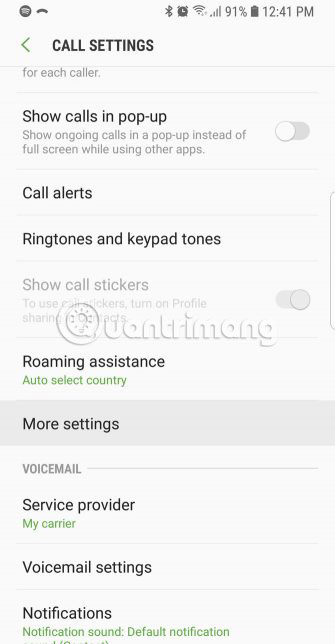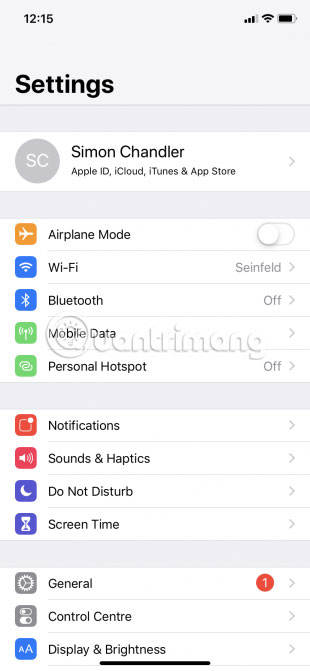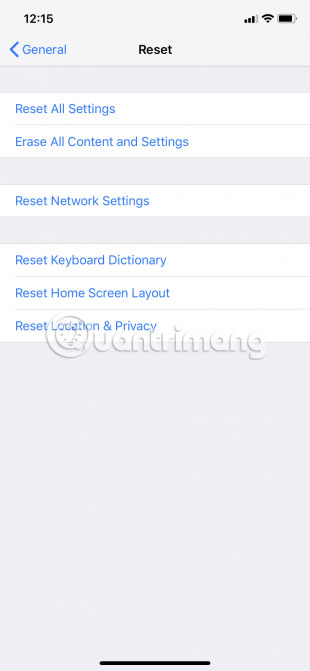How to use call forwarding on iPhone and Android
Call forwarding is a way to transfer calls to another number. This feature is available on Android and iPhone, very easy to set up. With call forwarding, you can avoid annoying work-related calls when on holiday. Calls can also be transferred to another phone in case your frequently used device has a problem.
Can easily activate the feature with a few simple steps. Similarly, solving problems with call forwarding is also quite simple. So don't worry if you're not sure how to use call forwarding on your iPhone or Android. Details will be in the following article!
How to take advantage of call forwarding options on iPhone and Android
- How to use call forwarding on iPhone
- How to use call forwarding on Android
- What to do when call forwarding does not work?
How to use call forwarding on iPhone



Setting up call forwarding on iPhone is extremely simple. You just go to Settings and make some adjustments as follows:
1. Open Settings.
2. Scroll down and click Phone.
3. Press Call Forwarding.
4. Move Call Forwarding to On (green).
5. Next, touch Forward To.
6. Enter the number you want to forward the call to.
7. Press Call Forwarding (in the top left corner of the screen) to exit.
The iPhone will forward calls to the entered number. Also, if you divert calls to landlines, remember to enter the area code as well.
The selected number will be based on why you want to use call forwarding. So if you simply don't want to be disturbed, forward the calls to a phone number in another location. For example, if you are at home, you can forward calls to your office phone. If you are on vacation, you can forward the call to your home phone.
You can also forward to the phone of a friend or family member. This option will work if your iPhone has a problem and important calls will not be missed.
When you want to deactivate call forwarding on your iPhone, just go back to this menu and click the Call Forwarding button again. Call Forwarding will move back to the 'Off' position (white) and the call will no longer be forwarded.
How to use call forwarding on Android



Pretty simple to set up call forwarding on Android. Follow these steps:
1. Open the Phone application .
2. Click the More button (vertical dots).
3. Click Settings. You may need to click More Settings or Call Settings , depending on the phone model and Android version.
4. Select Call Forwarding.
5. Select one of the 4 available options:
- Always forward sends all calls to the specified number.
- If you only want to divert calls when you are holding the device and you are busy, select Forward when busy .
- Forward when unanswered forwarding when you cannot answer the call.
- Finally, Forward when unreached only forward the call when the phone does not receive the call, in flight mode or is turned off.
6. Enter the number you want to forward the call. Again, be sure to enter the area code if forwarding to landline.
7. Click OK, Enable or Turn On to confirm.
You can deactivate call forwarding on Android by performing the same process. Click on each enabled option and then click Disable.
What to do when call forwarding does not work?



Using call forwarding on iPhone is usually very simple, but sometimes it can also be a problem. In general, the main problem is that the calls are not forwarded and you continue to receive them on your original phone. In special cases, you cannot set up call forwarding, perhaps because the Call Forwarding option cannot switch to On status .
Fortunately, there are several ways to solve such problems.
1. Make sure you have entered the correct phone number.
Using inaccurate numbers is also useless as no numbers are entered. You should double-check the entered number and also make sure that the number is active.
2. Turn off mobile data and then turn it back on. In support forums, some mobile operators recommend that users turn off mobile data, turn off call forwarding and then turn on both options again. You can do this by visiting Settings> Cellular on iOS and Settings> Network & internet> Mobile network on Android.
3. Restart the device.
4. Update phone. If you are an iPhone user, learn how to update iOS. On Android, go to Settings> System> System update .
5. Reset your phone's network settings.
- If you have an iPhone, you can do this by going to Settings> General> Reset> Reset Network Settings .
- If you have an Android phone, go to Settings, then click General Management or System. From there, search for one of the Reset Options, Reset Wi-Fi, Mobile, and Bluetooth options or Network Settings Reset .
Also, if you can't set up call forwarding using the Settings section of your phone, try it through your mobile service provider. This applies to both iPhone and Android users.
Hopefully, you don't have to try any of the above troubleshooting measures, because call forwarding is often a simple and effective feature. Take advantage of the feature if you don't want to be bothered by calls.
Hope you are succesful.
You should read it
- How to set up Port Forwarding in Windows
- How to set up Port Forwarding on Draytek router
- How to prevent email forwarding in Outlook and Gmail
- How to Forward Your Home Phone to a Cell Phone
- How to set up Port Forwarding on Netgear router
- Selective Forwarding attack in wireless sensor networks
- How to call video call on Zalo PC
- Zalo allows direct calling from contacts
May be interested
- How to set up Port Forwarding on Draytek router
 because this firewall blocks incoming connections, you may need to open a port through which for certain games and applications. to do this, you will have to forward the port with a process called port forwarding.
because this firewall blocks incoming connections, you may need to open a port through which for certain games and applications. to do this, you will have to forward the port with a process called port forwarding. - How to call video call on Zalo PC
 calling video calls is a new feature in the zalo pc version, allowing users to call video directly from zalo on the computer.
calling video calls is a new feature in the zalo pc version, allowing users to call video directly from zalo on the computer. - How to delete call history on iPhone, Android phones
 in the following tutorial, tipsmake.com guides readers how to delete call history on iphone, android phones easily and quickly.
in the following tutorial, tipsmake.com guides readers how to delete call history on iphone, android phones easily and quickly. - 3 easy ways to record calls on iPhone
 there are many cases where you need to record calls on your iphone, from job exchange, customer care to interviews. these are the most effective ways to save these conversations.
there are many cases where you need to record calls on your iphone, from job exchange, customer care to interviews. these are the most effective ways to save these conversations. - Top app for recording iPhone call history
 iphone call history stores more than a thousand calls, but you can only see the most recent calls you have made. however, you can download some applications that record call history.
iphone call history stores more than a thousand calls, but you can only see the most recent calls you have made. however, you can download some applications that record call history. - iPhone error again after updating iOS 13.1.2
 in the latest update to ios 13.1.2, many users have reflected on their device constantly experiencing errors related to the call after the update.
in the latest update to ios 13.1.2, many users have reflected on their device constantly experiencing errors related to the call after the update. - How to Forward Your Home Phone to a Cell Phone
 this wikihow teaches you how to forward calls from your home phone to your cell phone, which will allow you to receive calls to your home phone on your cell phone. check your carrier's policy on call forwarding. most carriers support call...
this wikihow teaches you how to forward calls from your home phone to your cell phone, which will allow you to receive calls to your home phone on your cell phone. check your carrier's policy on call forwarding. most carriers support call... - How to create a quick reply to a call on iPhone
 on the iphone there is a quick reply function by texting calls that you cannot listen to, with the option to edit the message content.
on the iphone there is a quick reply function by texting calls that you cannot listen to, with the option to edit the message content. - Where is the iPhone headset and Android headset different? Causes and ways to fix iPhone headset errors are not available on Android phones
 although the same 3.5 mm jack is used, when you plug in an iphone headset to an android device, it cannot be used and vice versa. so is the iphone headset and android headset really the same? what is the reason for not using iphone headphones on android phones?
although the same 3.5 mm jack is used, when you plug in an iphone headset to an android device, it cannot be used and vice versa. so is the iphone headset and android headset really the same? what is the reason for not using iphone headphones on android phones? - How to Receive Full Screen Calls on iPhone
 some users prefer the full screen call interface on iphone for easier viewing. it's very simple, we just need to change the call settings on iphone.
some users prefer the full screen call interface on iphone for easier viewing. it's very simple, we just need to change the call settings on iphone.










 How to listen to two songs at the same time on iPhone
How to listen to two songs at the same time on iPhone How to debug websites on iPad
How to debug websites on iPad How to hack pass wifi with WiFi Map everywhere
How to hack pass wifi with WiFi Map everywhere How to secure data with Jumbo: Privacy Assistant
How to secure data with Jumbo: Privacy Assistant How to create interesting math-style alarms on iPhone
How to create interesting math-style alarms on iPhone How to change Cydia iPhone home page interface
How to change Cydia iPhone home page interface